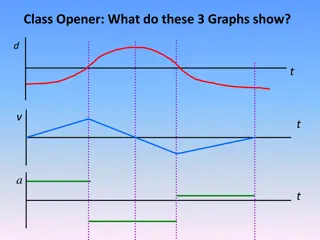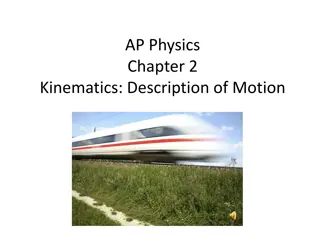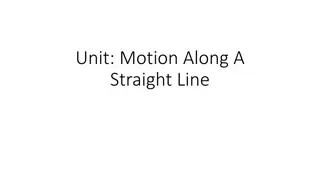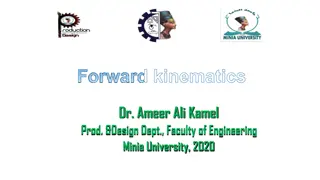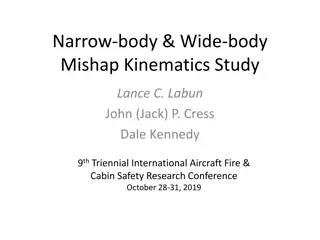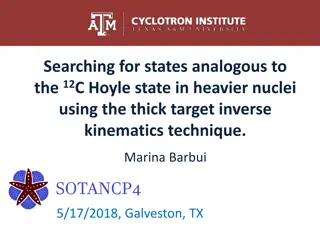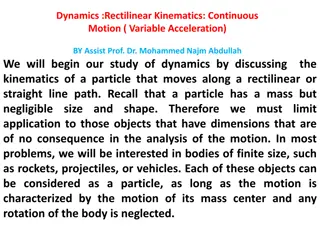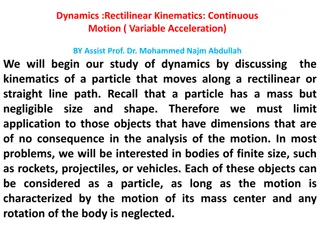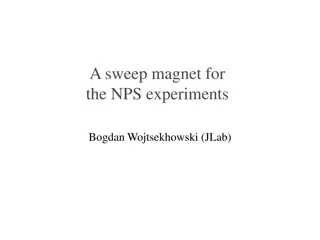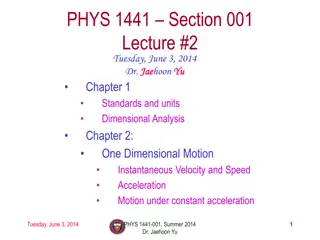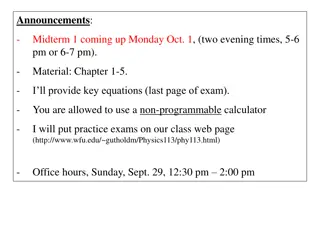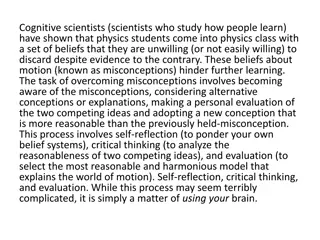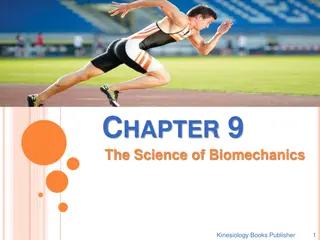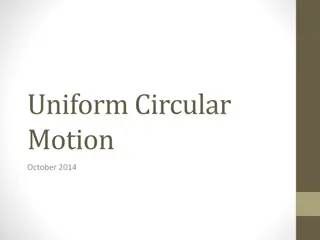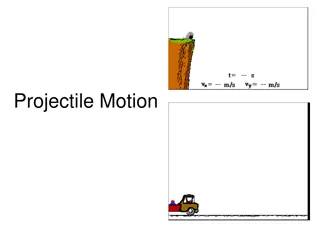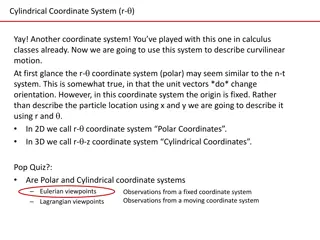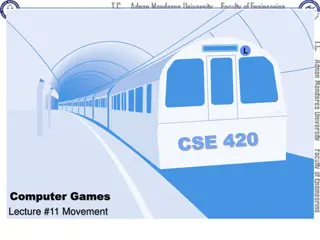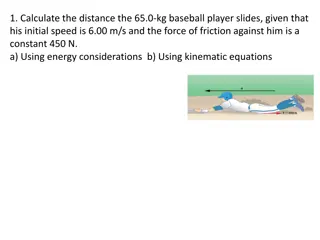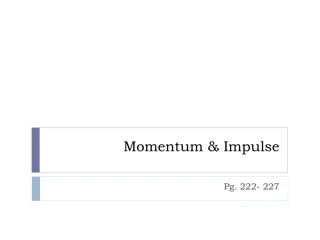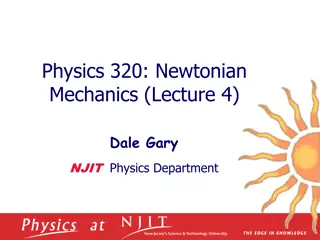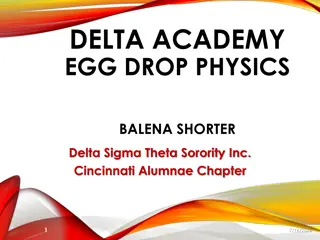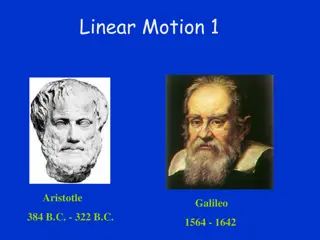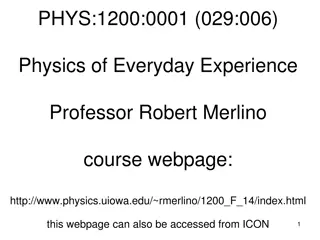Understanding Kinematics in Physics: The How and Why of Motion
Explore the fascinating world of kinematics in physics through the concept of motion, acceleration, and free-fall. From constant acceleration to projectile motion, unravel the principles behind bodies in motion. Delve into the discoveries of scientists like Galileo and experience free-fall demonstrations that showcase the effects of gravity. Test your knowledge with engaging questions and discover the independence of horizontal and vertical motions in projectile physics.
Uploaded on Sep 25, 2024 | 0 Views
Download Presentation

Please find below an Image/Link to download the presentation.
The content on the website is provided AS IS for your information and personal use only. It may not be sold, licensed, or shared on other websites without obtaining consent from the author. Download presentation by click this link. If you encounter any issues during the download, it is possible that the publisher has removed the file from their server.
E N D
Presentation Transcript
VCE-Physics - The how and why of motion A/Prof Martin Sevior martines@unimelb.edu.au Thursday, February 23rd School of Physics, 1 University of Melbourne
Kinematics How bodies move Special case of Constant Acceleration (1) (2) (3) (4) 2
2.5 Constant acceleration Free fall of a ball released from rest 0 t (s) x (m) x (m) vav= x/ t (m/s) aav= v/ t (m/s2) 0.0 0 0.49 1 0.049 9.8 9.8 9.8 9.8 9.8 9.8 9.8 9.8 9.8 0.1 0.049 1.47 0.147 0.2 0.196 0.245 2.45 2 0.3 0.441 0.343 3.43 0.4 0.784 0.441 4.41 3 0.5 1.225 0.539 5.39 0.6 1.764 0.637 6.37 0.7 2.401 4 0.735 7.35 0.8 3.136 0.833 8.33 0.9 3.969 5 x 0.931 9.31 1.0 4.900 (m) 3
x 2.5 Constant acceleration SJWW 2.6,7 5 Position 4 Gravity constant downward acceleration of 9.80 m/s2 3 2 1 We don t know the weight of the ball! 1t 0.2 0.4 0.6 0.8 10v Aristotle: Heavier objects should fall faster than light ones Velocity 8 6 Galileo: acceleration independent of mass 4 2 Galileo Galilei 1t 0.2 0.4 0.6 0.8 10a 8 Acceleration 6 4 2 1t 0.2 0.4 0.6 0.8
Free-fall demonstrations - SJWW 2.7 Apollo 15 Hammer and Feather Drop http://nssdc.gsfc.nasa.gov/planetary/lunar/apollo_15_feather_drop.html http://www.youtube.com/watch?v=5C5_dOEyAfk 5
Question Sam jumps out of a tree and lands on a trampoline. The trampoline sags 60cm before launching Sam back into the air. At the very bottom, where the sag is greatest, the direction of Sam s acceleration is: A. Upwards B. Downwards C. Zero 7
2 Dimensional Kinematics You all already do 2-D kinematics in your head, i.e. when someone throws you a ball you can catch it. cricket 8
Projectile motion A projectile is any object that is thrown, projected or dropped, thereafter moving under the dominant influence of gravity. Kinematics of projectiles Horizontal and vertical motions are independent (i.e. one does not affect the other). If gravity is the only force acting (no air resistance): Vertical acceleration is constant and equal to the free-fall acceleration due to gravity: downwards with magnitude g = 9.8ms-2. Horizontal acceleration is zero. D Ballistic Cart 9
Question At the highest point of the ball s flight, the ball is A. accelerating upwards B. accelerating downwards C. accelerating to the right D. not accelerating (i.e. a = 0) Consider change in velocity near highest point ?? ? = ?? ?? ?? Physics: Fundamentals 12
Why things move - Newtons laws of motion Newton I (law of inertia) An object will continue to move with constant velocity (or, if at rest, remain at rest) unless a net force causes its velocity to change. Newton II (acceleration is due to forces) An object subject to a net force will accelerate in the direction of the net force at a rate proportional to the force and inversely proportional to the object s mass. Newton III (action/reaction) For every force on an object, there is a force of equal magnitude but opposite direction on some other object. These are the inevitable consequence of a fundamental symmetry of Nature! The Laws of Nature are the same in regions of space-time (2nd year Physics!) 13
Newtons First Law Newton I (law of inertia) An object will continue to move with constant velocity (or, if at rest, remain at rest) unless a net force causes its velocity to change. Ballistic Cart Demo 14
Newtons Second Law cause effect ???? ? Newton s second law of motion ? = SI unit of force: kg m s-2 ? = ? ? Newton (N) kg m 1 N 1 2s 15
Newtons Third Law For every action, there is an equal and opposite reaction Important points about the language of this law: Newton is talking about an interaction between two objects. Newton III is specifically about force, and there is no more general meaning to the word action in this context. Nothing in Newton III specifies which force is the action and which is the reaction . We are free to label them either way. D Ballistic Cart Vital points in understanding Newton III: Forces in an action/reaction pair always act on different objects. Action/reaction forces always have equal magnitudes and opposite directions. 16 D Jet propulsion
Newton III Action/reaction force pairs - SJWW 4.6 All forces result from interactions between objects: These two forces have equal magnitude but opposite directions, and are known as an action/reaction pair or an interaction pair . Force of hand on apple Force of apple on hand Action-reaction (air track) Physics: Fundamentals 17
More about action/reaction pairs - SJWW 4.6 Consider all the forces on the apple. Force of hand on apple Force of Earth on apple Forces are equal and opposite. Is this an action/reaction pair? 18
More about action/reaction pairs - SJWW 4.6 No! Not an action/reaction pair, because the forces both act on the same object (the apple)! Force of hand on apple Force of Earth on apple Force of apple on hand Interaction pairs always involve two objects. For each force on the apple, there must be a reaction force on some other object. Force of apple on Earth 19
Question A small car is pushing a large truck that has a dead battery. The mass of the truck is much greater than the mass of the car. Which of the following is true? A. The car exerts a force on the truck, but the truck exerts no force on the car. B. The car exerts a larger force on the truck than the truck exerts on the car. C. The car exerts the same amount of force on the truck as the truck exerts on the car. D. The truck exerts a larger force on the car than the car exerts on the truck. E. The car exerts no force on the truck; the truck simply gets in the way. 21
Fluids A fluid is a substance that can flow, and will conform to the boundary of a container Solids are those materials that show a threshold below which an applied force will produce no permanent deformation. Fluids have no such threshold.
Pressure F p = Pressure: A Unit = N/m2 = Pascal, Pa Pressure is a scalar: each small volume element exerts pressure forces in all directions and these forces must be equal The pressure at a point in a static fluid is the same in all directions If not what would happen? 23
Vacuum Bazooka ????? ???? => ? = ? ? Pressure is Force/Unit area ie ? = Air is a fluid with a pressure of 105 Newtons/m2 Length = 2 m Air Pressure Vacuum Ping-pong ball diameter = 4 cm, so area = r2 = x(0.02)2 = 1.3x10-3 m2 Mass of ping-pong ball = 2.7 g = 0.0027 kg Force on ball = (Air Pressure)x(area of ball) = 105 x( r2) = 1.3x10-3x105= 130 N ? ?= 130 0.0027= 4.7 104 ?? 2 Now use Newton s 2nd Law: ? = 2= 2? ? = 2 4.7 103 2 2 ?? Constant acceleration formula: ?? =>??= 2 4.7 104 2 = 430 ?? 1 (1600 km/hr , bloody fast!) Lets try it! (DIY https://www.thenakedscientists.com/get-naked/experiments/vacuum-powered-bazooka) https://www.thenakedscientists.com/get-naked/experiments/vacuum-powered-bazooka 24


